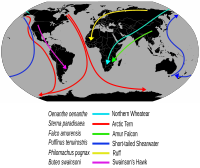
Photo from wikipedia
Abstract Technological advances in migratory tracking tools have revealed a remarkable diversity in migratory patterns. One such pattern is leapfrog migration, where individuals that breed further north migrate to locations… Click to show full abstract
Abstract Technological advances in migratory tracking tools have revealed a remarkable diversity in migratory patterns. One such pattern is leapfrog migration, where individuals that breed further north migrate to locations further south. Here, we analyzed migration patterns in the Painted Bunting (Passerina ciris) using a genetic‐based approach. We started by mapping patterns of genetic variation across geographic space (called a genoscape) using 386 individuals from 25 populations across the breeding range. We then genotyped an additional 230 samples from 31 migration stopover locations and 178 samples from 16 wintering locations to map patterns of migratory connectivity. Our analyses of genetic variation across the breeding range show the existence of four genetically distinct groups within the species: Eastern, Southwestern, Louisiana, and Central groups. Subsequent assignment of migrating and wintering birds to genetic groups illustrated that birds from the Central group migrated during the fall via western Mexico or southern Texas, spent the winter from northeastern Mexico to Panama, and migrated north via the Gulf Coast of Mexico. While Louisiana birds overlapped with Central birds on their spring migratory routes along the Gulf Coast, we found that Louisiana birds had a more restricted wintering distribution in the Yucatan Peninsula and Central America. Further estimation of the straight‐line distance from the predicted breeding location to the wintering location revealed that individuals sampled at lower winter latitudes traveled to greater distances (i.e., the predicted breeding area was further north; p > .001), confirming that these species exhibit a leapfrog migration pattern. Overall, these results demonstrate the utility of a genoscape‐based approach for identifying range‐wide patterns of migratory connectivity such as leapfrog migration with a high degree of clarity.
Journal Title: Ecology and Evolution
Year Published: 2023
Link to full text (if available)
Share on Social Media: Sign Up to like & get
recommendations!